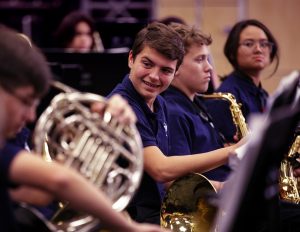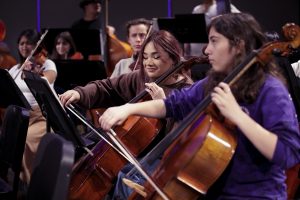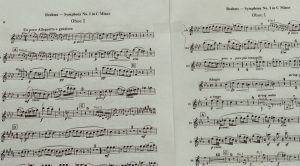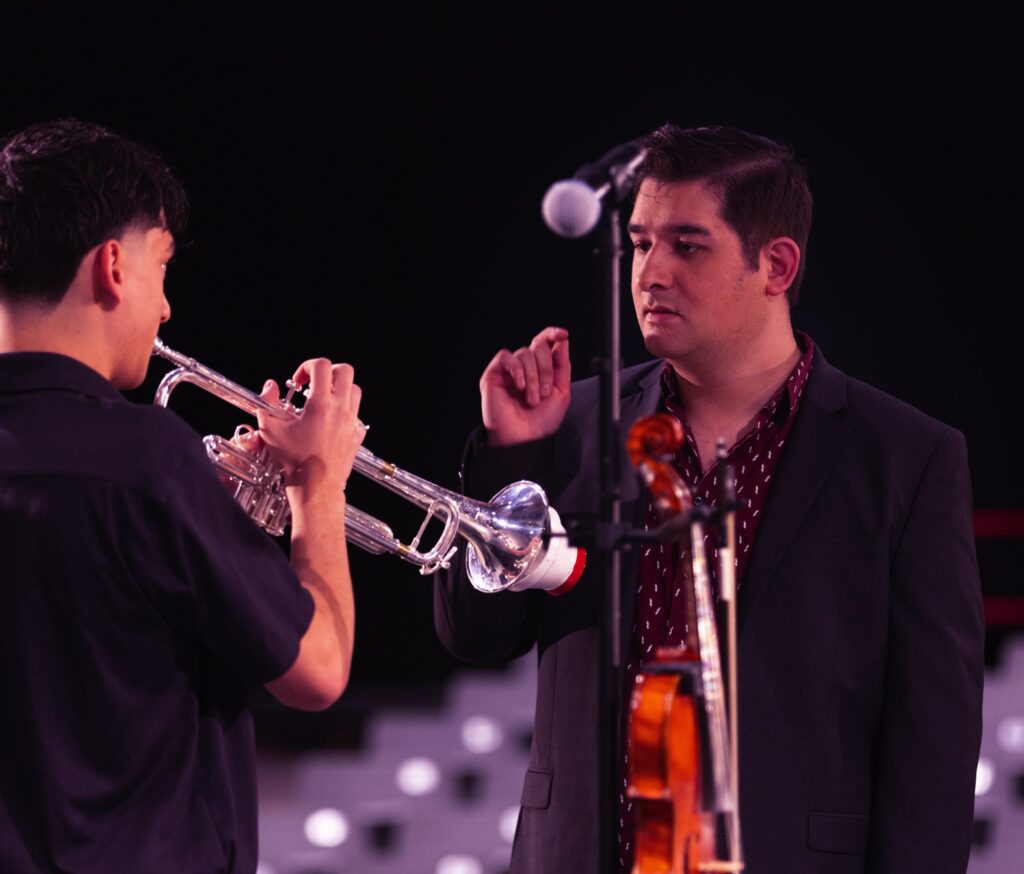Tagged Under:
What To Do When You Don’t Know What to Do
Oftentimes, new band directors find that they don’t know what to do to improve the sound of their bands. Don’t throw in the towel. Lean on mentors and colleagues, do research and practice!
Early in my career as a music educator, I knew I wanted a group that sounded good! However, I was unsure how to achieve it. I listened to bands with impressive tone quality, balance, intonation and style. Then there was my band. Every time we rehearsed, I couldn’t figure out all the things that needed addressing. I grappled with developing good intonation within my group because I couldn’t hear where the wrong notes were coming from and how out of tune things actually were.
After a few years, I came to a harrowing realization: I was not naturally talented at this.
A Look Back

I was a good trumpet player since the 7th grade, but I was not a natural. We started band in 4th grade in Joliet, Illinois, and I’m pretty sure that from the ages of 9 to 12, I made my poor beginning band instructors suffer far more than they needed to. At the end of 6th grade, my mother became fed up with how I sounded.
My older brother was a very successful trumpet player — full ride to college, lead soloist at Disneyland, etc. And me? I faked being sick to get out of playing a solo at church because I knew how bad I sounded.
My mother told me that from now on I would practice the trumpet for 40 minutes a day. I complained that the band director said we only needed to practice 30 minutes a day, but my mother told me that she knew that 1) I would screw around for at least 10 minutes, and 2) I had to make up for lost time. So, I practiced. Every day. And I got better. A LOT better.
Clearly, I couldn’t rely on my mother to force me to practice to become better at band rehearsing. I was lost. Fortunately, through the help of method books, friends and mentors, I was able to “practice” band rehearsing more and provide a better experience for my students.
Here’s what I did.
Expand Your Listening Horizon
 I enjoy live music, but hearing exceptional groups reduced my confidence. Still, it was important to continue this exposure, not only to continue getting examples of what I wanted, but for my own enjoyment as well.
I enjoy live music, but hearing exceptional groups reduced my confidence. Still, it was important to continue this exposure, not only to continue getting examples of what I wanted, but for my own enjoyment as well.
One of the most effective ways to refine your ear is to immerse yourself in the music of various groups. Seek out live performances whenever possible. Witnessing a musical ensemble in action can provide a new perspective on how sound interacts in a real-time setting. Exposure to different styles and interpretations will expand your auditory repertoire, enhancing your ability to distinguish subtleties.
Collaborative Learning
The responsibility was on me to get this group where it needed to go, but not on me alone. I could explain to the kids what I was trying to do until I was blue in the face, but it went a lot quicker when I was able to bring kids to live performances to say, “See, this is what we want, and this is what is possible.”
The journey to hone your listening skills need not be a solitary one. Encourage your ensemble members to listen to other groups as well. By sharing experiences and discussing what each person hears, you collectively broaden your auditory awareness. The interplay of different perspectives can lead to richer insights and a more nuanced understanding of musical intricacies.
Peel Back the Onion and Rehearse Systematically
 We know when something doesn’t sound like we want it to, but what do we do when we’re in the middle of rehearsal? If something sounds off but you can’t put your finger on it, start separating the parts. Break down complex pieces to understand them better.
We know when something doesn’t sound like we want it to, but what do we do when we’re in the middle of rehearsal? If something sounds off but you can’t put your finger on it, start separating the parts. Break down complex pieces to understand them better.
I thought this would be a waste of time, but it turns out, I was able to either reinforce what students were doing right, find the problem quicker or in some instances, find out that we had a lot more issues in some sections, which is OK!
In these cases, honesty always works best. “Band — something could be better, but I’m having trouble hearing where. Let’s go section by section from A to B. Flutes, first, then oboes and clarinets, etc.”
Diagnosing the problem becomes much easier, and you’ll soon find out that there is always something to offer feedback about! Put it back together, and the kids (and you) start noticing the results as well.
We use a formula to make sure every element of music is addressed. For example, during the rehearsal from point A to B, the first round could focus on rhythm, the next on note accuracy, followed by balance, and finally intonation. This formula was also something that worked wonderfully when I had to be absent: students leading the ensemble could use this process to make sure we had a productive rehearsal regardless of who was in front of them.
Practice Tuning
 Whether they sound off or not, make a habit of tuning specific notes and chords to ensure uniformity. I started by picking one student to play a note. I then played my instrument and tuned to them. This showed an example of what “in tune” sounded like. Later, we started having kids tune to each other — just a couple each day.
Whether they sound off or not, make a habit of tuning specific notes and chords to ensure uniformity. I started by picking one student to play a note. I then played my instrument and tuned to them. This showed an example of what “in tune” sounded like. Later, we started having kids tune to each other — just a couple each day.
As we progressed, I started picking sustained chords in the pieces we were performing. Early on, I really couldn’t tell how out of tune certain chords were, so we just spent time going through each note and each student, working with drones and tuners, and got this chord in tune. Sometimes this took nearly an entire class period, but the results were fantastic. Kids were still having trouble tuning some chords, but now they knew the difference between in tune and out of tune, and they wanted to do something about it.
We continued the routine of tuning sustained chords that appeared in the piece, and the process kept getting more efficient. If something was grossly out of tune, kids would start crinkling their nose up in a disgusted face — aka as “the look” that band directors consider an indicator of success!
Technology and Score Study
Tools like the Yamaha Harmony Director or TonalEnergy app can be invaluable in identifying and correcting sound inconsistencies. Utilizing music assessment software can also help students prepare parts on their own. Machines don’t lie!
 Delve deep into the music, studying one line at a time. I’m serious. Take a piece and plunk out every single instrument line on the piano, or grab an instrument and play through. Go through every line and see what your kids are actually playing. Then do it again. Then one more time.
Delve deep into the music, studying one line at a time. I’m serious. Take a piece and plunk out every single instrument line on the piano, or grab an instrument and play through. Go through every line and see what your kids are actually playing. Then do it again. Then one more time.
This may seem monotonous, and yes, it will take some time. Trust me: If you are having difficulty reading scores or hearing parts, this will be time well spent. Familiarize yourself with every detail and your students will benefit.
Research, Learn and Pay Attention to Detail
Books like “Practicing Successfully” by Elizabeth A.H. Greene provide invaluable insights into refining practicing techniques that can be passed on to your students. I’ve mentioned “Atomic Habits” by James Clear in this article. These habits can be instilled into your ensemble routines to create a consistent method that works.
Don’t forget about your state and national conventions, and especially your colleagues. Be specific and ask for help!
In the pursuit of musical excellence, sweat the small stuff — every detail matters. Even seemingly trivial factors like the arrangement of chairs, which can influence sound projection and balance. A meticulously planned rehearsal space can contribute to promoting your students to create an effective musical experience.
From Struggle to Striving
My story began in Joliet, where I, unlike my accomplished trumpet-playing brother, was not a musical prodigy. After facing years of struggle and under the guidance of my mom, I developed into a skilled trumpet player. But when it came to leading students, I felt like that young kid again.
However, with persistence, the right tools and guidance from mentors and method books, I managed to hone my skills. The journey taught me that no matter where we start, with the right strategies and dedication, we can achieve our goals.















